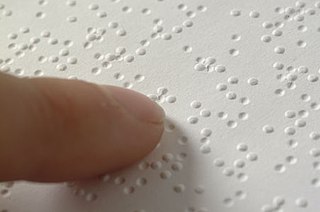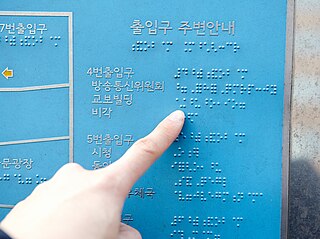Script

As in modern braille, most of the higher decades were derived from the first:
- Decades 1–4 were the same as today and had their modern French values.
- Decade 5 was not derived from the first. (See image at left or table below.) Like the first decade, only the top half of the cell was used. [2] The digit 1 was a dash in the top row; 2 was dashes in the top and mid rows. (That is, these were a and b, or modern digits 1 and 2, but with dashes in place of dots.) 3–5 were a top dash with a left, double, and right dot in the middle; 6–8 were a mid dash with a left, double, and right dot at top. 9 and 0 were a and b shifted to the right (that is, the modern French superscript and currency signs, ⠈ and ⠘):

- Decade 6 was derived from the first by adding dash at the bottom. That is, it resembled the 3rd decade with the two bottom dots connected into a line.
- Decade 7 was formed with a dash in the top row of the cell, displacing the dots of the first decade downward. That is, it was much like the modern fifth decade with an overstruck dash at the top. For the 1st and 3rd characters of the decade, however, the dots were shifted all the way down to the bottom row, rather than shifted once to the middle as in the modern 5th decade: No character outside the original 1st and 5th decades occupied just the top half of the cell.
- Decade 8 was formed by splitting the first decade with a dash, placing it between the upper and lower parts of each sign. [3] That is, a dash appeared in the middle row, displacing the dots of that row to the bottom of the cell. In the case of first and 3rd characters (from a and c), which did not have dots in the middle row, the dots at the top were displaced to the bottom instead. That is, this decade was equivalent to adding an overstrike to ⠄⠅⠤⠩⠡⠍⠭⠥⠌⠬.
- Decade 9 was derived from the fifth (the digits) by adding a dash in the bottom row. These were left unassigned apart from the first three, which were used when needed as markers of words, music, and plainsong, respectively.
Thus the 1st and 5th decades occupied only the top half of the cell, while all characters in the other decades had a dot or dash in the bottom row.
Table
| Decade | numeric sequence | |||||||||
|---|---|---|---|---|---|---|---|---|---|---|
| I | a | b | c | d | e | f | g | h | i | j |
| II | k | l | m | n | o | p | q | r | s | t |
| III | u | v | x | y | z | ç | é | à | è | ù |
| IV | â | ê | î | ô | û | ë | ï | ü | œ | w |
| V | 1 | 2 | 3 | 4 | 5 | 6 | 7 | 8 | 9 | 0 |
| VI | , | ; | : | . | ? | ! | ( ) | « » | * | | |
| VII | + | − | ± | = | < | > | × | ※ | ²√ | . |
| VIII | : | ∷ | ÷ | ∺ | | | | | | |
| IX | | | | | | | | | | |
| Supp. | ' | - | ∝ | | | | ||||
The supplemental signs were ⠄⠤⠜⠼ and a top dash with ⠠⠰. [4] Of the 125 (53) possible patterns, 97 were used. The modern 5th decade and other supplemental signs do not appear in the 1829 version of braille, apart from ⠐ and ⠒ in plainsong notation.
Punctuation differed slightly from today, even accounting for the shift downward when the dash was dropped from the bottom row of the cell. ⠶ was used for both parentheses, as in modern English braille. ⠦ was used for either quotation mark; ⠴ was a pipe. ⠢ was the question mark, as in modern French braille, while ⠔ was the asterisk, which is used doubled in English braille.
Substitutions for the dash
Anticipating that the dashes might prove problematic, Braille provided that the supplemental sign ⠼ (now known as the number sign) would shift the decade by four. That is, adding it to the first four decades would produce substitutes for the fifth through eighth. Only its use to replace the old fifth decade has been retained; the old sixth decade survives as the modern fifth, with the dash removed and the dots shifted down to replace it. The original proposal was as follows:








